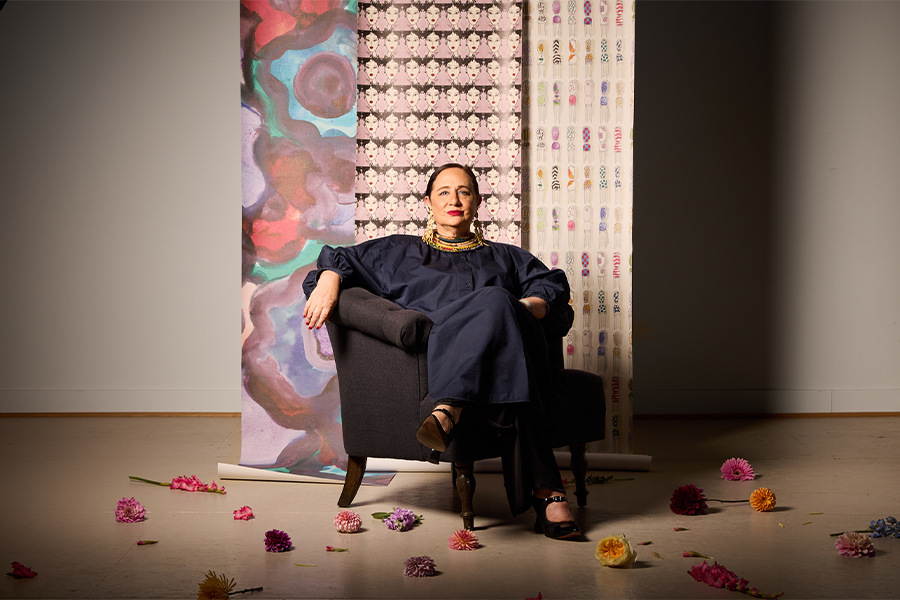The next edition of Heimtextil is around the bend. From January 14–17th, Germany’s sprawling Messe Frankfurt exhibition grounds will once again host the largest international trade fair for residential and contract textiles, and this time around, there are a few new bold additions to look forward to.
Alcova is known for orchestrating intriguing installations during Milan and Miami’s design weeks. The nomadic design platform, founded by curator and creative director Valentina Ciuffi of Studio Vedèt and architect Joseph Grima of Space Caviar, has previously taken over the likes of a riverside hotel, a former orchid greenhouse, and a one-time panettone factory.
Now, Alcova is lending its distinctive design perspective to Heimtextil by curating Heimtextil Trends 25/26. Fueled by the power of language and cultural narratives, this expansive portion of the fair will highlight the theme “Future Continuous,” delving into the ever-evolving connection between the past and what lies ahead through the notion of renewal.
Spanish architect and designer Patricia Urquiola also announced her upcoming partnership with Heimtextil. For 2025, her studio is planning an eye-opening presentation that examines the role of textiles in product design and interiors but also articulates a vision that transcends the industry.
Before jumping ahead, however, HD takes one last look at the 2024 show through a conversation with Anja Bisgaard Gaede. The Silkeborg, Denmark-based CEO, founder, and creative developer of SPOTT Trends & Business presided over Heimtextil Trends 24/25. Titled “New Sensitivity,” it investigated the idea of transformation through an array of technological, bio-engineered, and plant-based textiles, as well as sustainable dyeing methods.
Here, Bisgaard Gaede weighs in on how these materials can impact the hospitality realm.

Anja Bisgaard Gaede
Many of the textiles showcased in New Sensitivity were best suited to residences. Do you see potential for the hospitality market?
Anja Bisgaard Gaede: I do believe the hospitality sector is looking for alternatives. There’s still a gap between having these new materials and applying them. A lot are going through tests, particularly for durability. But some of the companies don’t have any barriers to production on a larger scale, which is needed for hospitality settings. PU [polyurethane] alternatives in particular, like the vegan cactus leather from Desserto, or the one from Periskin made with the waste of persimmons, are applicable to high-traffic areas in restaurants and hotel lobbies. Von Holzhausen uses bamboo and Oleatex works with a byproduct from the olive industry and they’ve also proven strong. So, some materials do live up to hospitality.
Is there an industry that has started to embrace these materials?
ABG: Transportation. Desserto has made a car seat and because Pond produces resins for bioplastics and textiles, it is looking into covering a whole car or train.
What would be a good starting point for hotels?
ABG: Softer plant-based textiles could be used for bedding, but they have to withstand the cleaning processes. I’m seeing more upscale options with Spinnova, which uses raw cellulose, and Noosa, an interesting bio-engineered yarn made from corn, which can also go into various elements of the bedding area. Ettitude Materials is making an almost silk-like alternative from bamboo.
What do you think is the biggest challenge to getting these materials into the hands of hospitality designers?
ABG: I think for the contract market it’s a price issue, not a material issue. It’s more about having the knowledge that these alternative materials actually exist out there and exploring them. What would they look like? What volumes are able to be produced? What is the pricing when you are working on hotels and restaurants?
How can the industry expedite this?
ABG: It can make the push for the penetration of these materials by requesting them at high volumes. Once these orders begin to come in, then we are going to see a transition in prices and we will be able to have things scaled to a larger extent. It’s a matter of the hospitality sector wanting to create new elements and taking on new standards. For example, there are some flame-retardant materials with plant-based coatings.
These imaginative options have eco-friendly appeal but how else do you think they could affect hospitality?
ABG: It’s a matter of changing the narrative of what is important to design. How long do textiles have to last before they are changed? Decor within a hotel is changed every five or 10 years. So if they are being changed anyway because of aesthetic reasons, then we might as well choose some better alternatives that we can then recycle or that don’t make as big an impact on the environment. Mindsets need to be worked on as well.
Beyond the composition of textiles, how are production processes innovating with sustainability in mind?
ABG: Some companies like Gabriel Fabrics are looking into how we can knit instead of weave in order to incorporate leftover scraps, maybe even recycled fibers, that are helpful in reducing waste.


